| |
- 1850 - 1854
- 1850 The New 12 Acre Tract
- 1851 Cemetery Lot Ledgers
- 1851 Order Regarding Burials
- 1851 Exposed Coffins
- 1853 Petition to Move the Cemetery
- 1854 The Cholera
- 1854 Dead Animals and Night Soil
From 1850 through 1854, the cemetery expanded northward as the previously surveyed grounds were consumed by interments.
In 1850, the city acquired Block 49, which had been part of Jacob Milliman's farm. In the 1860s, when the Supreme Court ruled the city acquired the lands illegally, the city was required to vacate the grounds and return the land to the Milliman heirs. Thus began the first disinterments from the City Cemetery. (See the Milliman Tract within the Contributing Factors in Moving the Cemetery section.)
On November 30, 1850, the Chicago Daiily Journal wrote: A neat and sufficiently spacious chapel has been erected upon the grounds by the City Sexton, and much attention and taste are displayed in beautifying the narrow domains of sleeping friends.
In 1851, the Common Council files began to contain extensive records of lot owners. Each record showed the surveyed lot number, cost per lot, and date of purchase. (See the chronological lot owner database.)
In 1852, Chicago saw its grandest funeral to date with the death of David Kennison.
Also in 1852, a mile-long white picket fence was built around the cemetery. (See the Fence section.)
In September 1854 the cemetery lot sizes were changed from 9 x 24 feet to 9 x 12 feet.
A 9 x 12' lot was enough space to hold four sets of remains.
Between the years 1850 and 1854, Chicago's population more than doubled, increasing from 28,620 to 70,000.
According to the Chicago Democrat newspaper, the population and mortality figures for those years were:
1850 28,620 1,332
1851 32,000 836
1852 38.733 1,649
1853 60,662 1,206
1854 70,000 3,827
Cholera outbreaks account for the high death rates during 1850 and 1854.
During six days in July, 1854 more than 200 cholera victims were buried in the Potter's Field.
(For more statistics, see The Numbers section.)
|
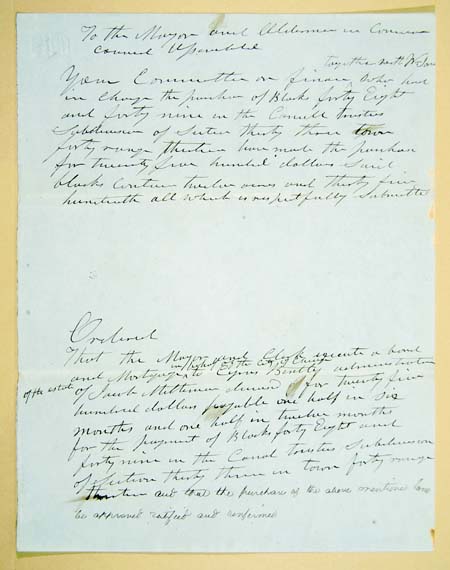
Courtesy of the Illinois Regional Archives Depository.
|
The acquisition of the 12-acre Milliman Tract was deemed, in 1865, to have been obtained illegally. By that time, the land had been surveyed and sold as 656 nine-by-twenty-four foot cemetery lots, each of which could hold up to eight bodies. The City was ordered to vacate the grounds and return the land to the Milliman heirs.
(See the Milliman Tract section.)
_______________
To the Mayor and Aldermen in Common Council Assembled
Your Committee on finance together with Wm Jones who had in charge the purchase of Blocks forty Eight and forty nine in the Canal trustees Subdivision of Section thirty three town forty range thirteen have made the purchase for twenty five hundred dollars Said blocks contain twelve acres and thirty five hundredths all which is respectfully Submitted.
Ordered
That the Mayor and Clerk execute a bond and Mortgage in behalf of the City of Chicago to Cyrus Bentley administrator of the estate of Jacob Mitteman (sic) deceased for twenty five hundred dollars payable on half in six months and one half in twelve months for the payment of Blocks forty Eight and forty nine in the Canal trustees Subdivision of Section thirty three in town forty range thirteen and that the purchase of the above mentioned land be approved ratified and confirmed. |
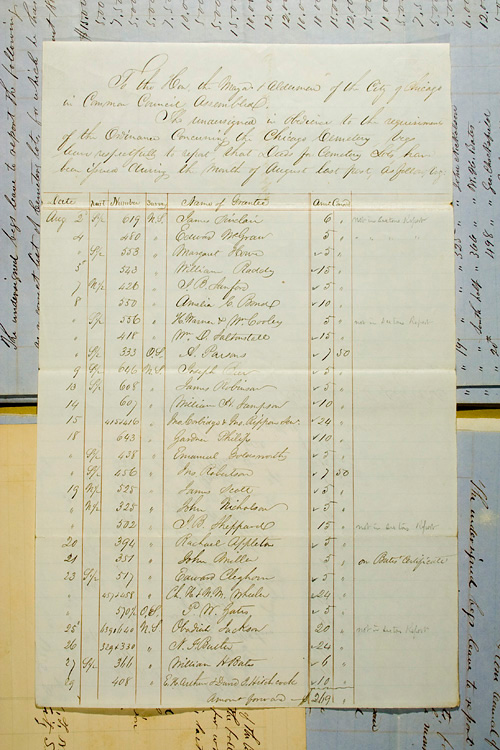
Courtesy of the Illinois Regional Archives Depository.
|
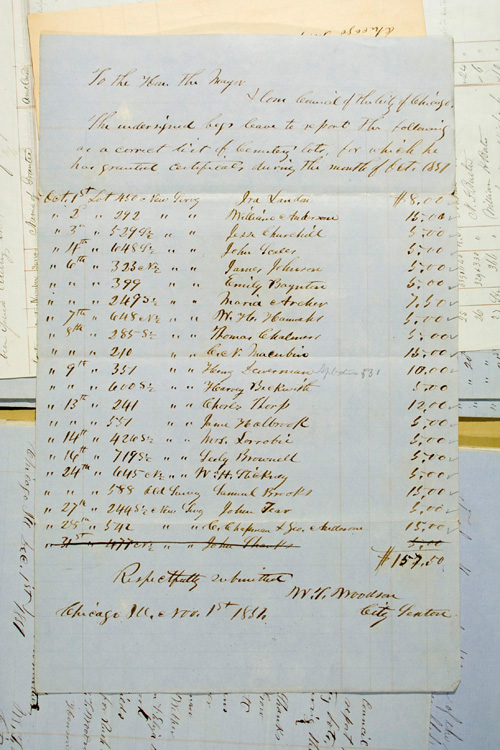 |
These ledger pages show the Chicago City Cemetery lots sold during the months of August and October, 1851.
The heading reads:
To the Hon the Mayor & Aldermen of the City of Chicago in Common Council Assembled.
The undersigned in obedience to the requirement of the Ordinance Concerning the Chicago Cemetery begs here respectfully to report, that Deeds for Cemetery Lots have been issued during the month of August last past, as follows beg
The columns read:
Date
Lot
Number
Survey
Name of Grantee
Amount Paid
See all lot owner information transcribed in chronological order HERE.
|
 Courtesy of the Illinois Regional Archives Depository.
Courtesy of the Illinois Regional Archives Depository.
|
This scrap of paper contains the following order from the Common Council from 1851:
Ordered,
That the Clerk caution the public by advertisement in the Corporation newspaper and other papers of the city, not to purchase Lots in the City Cemetery except from the City Sexton, W.T. Woodson and also to publish a List of Lots unsold which are occupied and which have not been paid for. |
| This memo indicates that coffins were becoming exposed in the earlier cemetery along the lake shore nearly ten years after that cemetery was supposedly vacated to the new City Cemetery. Later, in the Potter's Field, a section that was located nearest the lake shore in the City Cemetery, coffins which similarly became exposed were continually re-covered by the City Sexton. |
To the Mayor & Aldermen in Council assembled
Your Committee to whom is referred the order to bury the bodies exposed in the old burying ground have caused the same to be removed to the "Potters field" in the New Cemetery recommend the payment of the accompanying bill for removing the same
John C Haines Chm
May 12/51 |
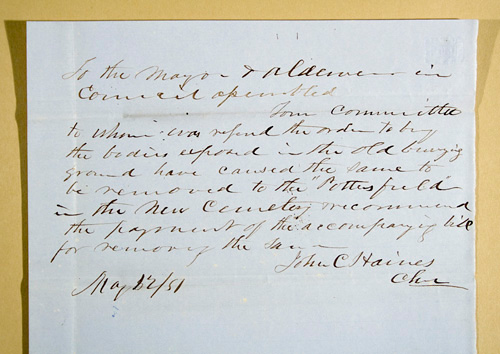
Courtesy of the Illinois Regional Archives Depository.
|
| At the time of this writing, Chicago was divided into three divisions: North, South and West. The direction indicated the area's placement in relation to the branches of the Chicago River. This, the earliest Common Council record of a request to move the City Cemetery, likely comes from four North Division business owners. By 1853, the cemetery was within the city limits. On September 11, 1854, Martin M. Ford, the first signer of the petition, paid $10 for Lot 1262 in the New Survey. (See the Mapping the Cemeteries section.) |
|
November 28, 1853 |
|
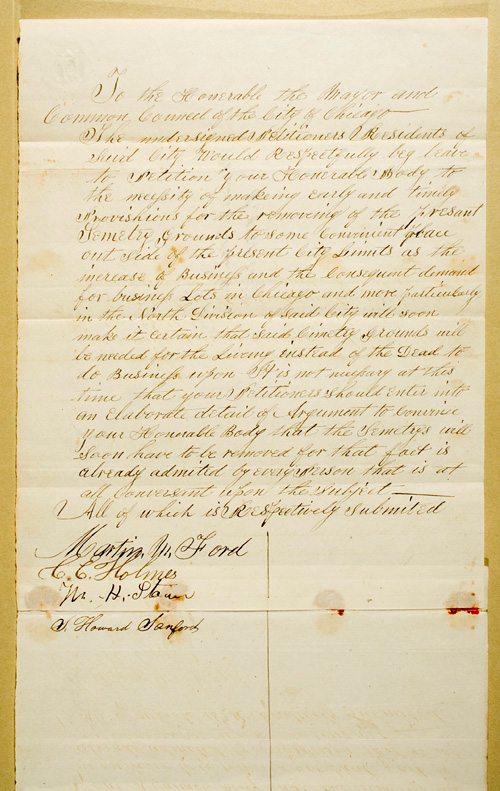
Both documents courtesy of the Illinois Regional Archives Depository.
|
(Petition copied verbatim)
To the Honerable the Mayor and Common Council of the City of Chicago –
The undersigned Petitioners Residents of Said City would Respectfully beg leave to Petition your Honerable Body to the necessity of makeing early and timely Provishions for the removeing of the presant Semetry Grounds to some conveinient place out side of the present City Limits as the increase of Business and the consequent demand for business Lots in Chicago and more particularly in the North Division of said City will soon make it certain that said Cimetry Grounds will be needed for the Liveing instead of the Dead to do Business upon. It is not necessary at this time that your petitioners should enter into an elaborate detail of Argument to convince your Honerable Body that the Semetrys will soon have to be removed for that fact is already admited by every person that is at all Conversant upon the Subject –
All of which is Respectively submitted
Martin M. Ford
C.E. Holmes
M.H. Stawn
S. Howard Sanford
Response to the Petition ----->> |
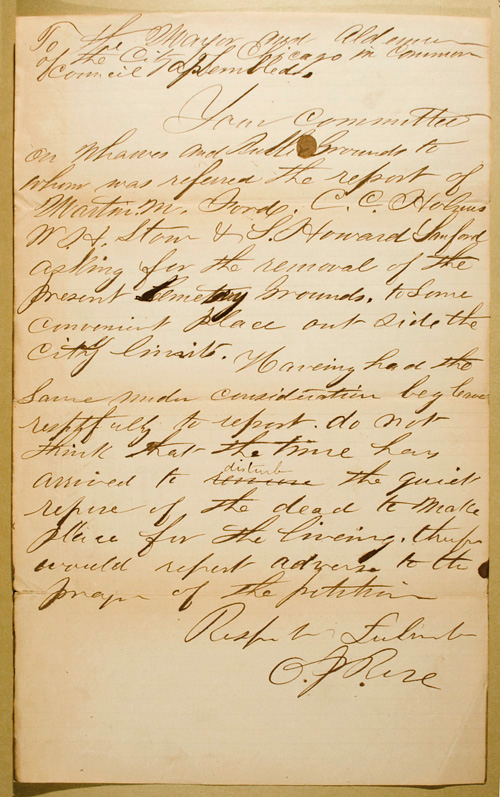 |
To the Mayor and Aldermen of the City of Chicago in Common Council asssembled.
Your Committee on Wharves and Public Grounds to whom was referred the report of Martin M. Ford, C.C. Holmes, W.H. Stow & S. Howard Sanford asking for the removal of the present Cemetery Grounds, to some convenient place out side the city limits. Haveing had the Same under consideration beg leave respectfully to report. do not think that the time has arrived to remove disturb the quiet repose of the dead to make place for the liveing. therefore would report adverse to the prayer of the petition
Respectfully Submitted
|
 |
This article, from the North-Western Christian Advodate newspaper, indicates that more than 200 cholera victims were buried in the City Cemetery's potter's field during a two-week period in July 1854.
(This newspaper snippet reproduction contains the highlighted keywords that I used to find this article on the Internet.)
__________________________
In a January 11, 1864 Chicago Tribune article reviewing the city's mortality rate since such records were kept, the figures pertaining to the summer of 1854 were even more dire:
The deaths occurred so rapidly that at first no accurate account could be taken of them. The interments in the first week of July were 242, in the second week 252, of these about three-fifths were credited to cholera, though there can be no doubt that the proportion was much greater. Of these 494 interments, only the names of 315 could be collected. In the remaining half of the month the deaths were 437 – total for July 931.
See the entire article, as well as other information about the cholera here.
See also, The Numbers section, and the Potter's Field section. |
In 1854, citizens began complaining of the practice of indivuals who were dumping dead animals and raw sewage at the northern edge of the City Cemetery. The following two documents detail the plea and response by the city officials.
An ordinance was enacted to bury dead animals, and other disagreeable matter in the city-owned lakefront grounds between today's Diversey and Fullerton Parkways.
|
 |
To the Common Council of the City of Chicago
The undersigned respectfully represent that persons unknown to them are in the habit of depositing dead animals, night soil and other offensive matter around the North end of the Cemetery grounds to the great annoyance of persons living or traveling in that vicinity and they respectfully ask your Honorable body to take such action in the premises as may be deemed advisable.
They would suggest that the SE frct 1/4 of Sec 28, T.40 R 14. belonging to the City be designated as the proper place for depositing such matter and that the practice making such deposits be compelled to bury them.
May 22, 1854
James H. Rees
E.S. Williams
Timothy Wright
|
 |
To the Mayor & Aldermen of the City of Chicago, in common Council assembled
Your Committee on Wharves & public grounds to whom was refered the petition of JH Rees and others in Relation to Deposits of Dead animals and other offensive matter in the north end of the Chicago Cemetery Grounds
Beg Leave to Report that they have examined & find the same to be the case and would ask the passage of the following order
Ordered that the city Marshall prosecute all persons who shall Deposit or cause to be Deposited any putrid or offensive substance Dead animals or other unwholesome matter of any kind Contrary to the ordinances of the City.
and that the health officers cause to be removed or buried all Nuisance or nuisances that now exist adjacent to the Chicago Cemetery on any part of Said City that may come to his Knowledge hereafter.
all of which is Respectfully submitted
JD Outhet, Chairman
Chicago June 5th, 1854 |
|